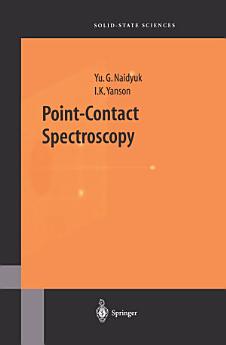Point-Contact Spectroscopy
Yu.G. Naidyuk · I.K. Yanson
abr. de 2019 · Springer Series in Solid-State Sciences Libro 145 · Springer
Libro electrónico
297
Páxinas
reportAs valoracións e as recensións non están verificadas Máis información
Acerca deste libro electrónico
The main goal of solid-state physics is investigation of the properties of the matter including the mechanical, electrical, optical, magnetic, and so on with the aim of developing new materials with defined characteristics. Nowadays, the synthesis of superconductors with high critical temperature it consists of or fabrication of new heterostructures on the base of semiconductors, in cre ation of layered, amorphous, organic, or nanofabricated structures and many others. To do all of these, the various methods of investigation are developed during the past. Because it is impossible to find an universal method to in vestigate a variety of materials, which are either conducting or insulating, crystalline or amorphous, thin-layered or bulk, magnetic or segnetoelectric, and so on, various kind of spectroscopies, like optical, neutron, electron, tun nel and so on, are widely used in solid-state physics. Recently, a new type of spectroscopy, namely, the Point-Contact Spectroscopy (PCS), was designed for study of the conduction-electron interaction mechanism with a whole class of elementary excitations in the solids. In PCS, a small constriction, about a few nanometers large, between two conductors plays a role of a spectrome ter. Namely, because of inelastic scattering of accelerated electrons, the I - V characteristic of such a tiny metallic contact is nonlinear versus an applied voltage and its second derivative surprisingly turns out to be proportional to the electron-quasiparticle-interaction spectrum.
Acerca do autor
Both authors are affiliated with the B. Verkin Institute for Low Temperatire Physics and Engineering, National Academy of Sciences of Ukraine.
Valora este libro electrónico
Dános a túa opinión.
Información de lectura
Smartphones e tabletas
Instala a aplicación Google Play Libros para Android e iPad/iPhone. Sincronízase automaticamente coa túa conta e permíteche ler contido en liña ou sen conexión desde calquera lugar.
Portátiles e ordenadores de escritorio
Podes escoitar os audiolibros comprados en Google Play a través do navegador web do ordenador.
Lectores de libros electrónicos e outros dispositivos
Para ler contido en dispositivos de tinta electrónica, como os lectores de libros electrónicos Kobo, é necesario descargar un ficheiro e transferilo ao dispositivo. Sigue as instrucións detalladas do Centro de Axuda para transferir ficheiros a lectores electrónicos admitidos.







